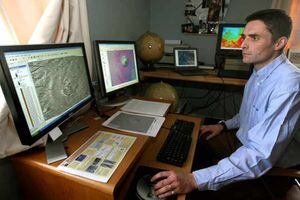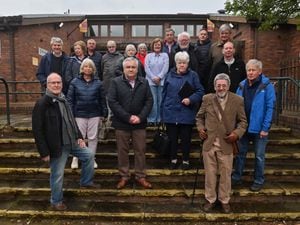Still over the moon
It is still mind-blowing that, when we look up at the moon we can say man has been there, done that, writes Ben Bentley.

It is still mind-blowing that, when we look up at the moon we can say man has been there, done that, writes Ben Bentley.
Forty years ago today, astronaut Neil Armstrong spoke his famous, if misquoted, words from the surface of the moon.
Moon website guide - click here
A "giant leap for mankind", it certainly was. But – and pardon the space pun – on July 20, 1969, could he have known the gravity of the phrase he had just uttered?
The space race between the US and the Soviet Union may have been over the moment a human foot was planted on the surface of the moon alongside the star-spangled banner, but the real quest of understanding our new, suddenly wide open world was only just beginning.
The United States space agency NASA achieved the first manned landing on earth's moon as part of the Apollo 11 mission commanded by Neil Armstrong who landed the lunar module Eagle on the surface of the moon, carrying himself and Buzz Aldrin, the second person to set foot on the moon as Michael Collins orbited above.
Armstrong and Aldrin spent a day on the surface of the moon before returning to Earth.
Make no mistake about it: the moment changed our world, for without the moon landing technology would not be where it is today and the way we understand the world would be different.
The technological context is important. The moon landing today would be easier. Far easier. But, for all the technology and computer acrobatics that have been developed in the last four decades, still not easy.
Remember, these were the days when computers were the size of house and couldn't do half of what your laptop from Curry's can do.
Your average family car probably has as much technology incorporated into it as Apollo 13 did back then. Imagine going to the moon in a jet-propelled Ford Mondeo and you are probably grasping a greater understanding of a 1960s lunar landing mission.
I personally have my earliest memories wrapped up in the moon landing. I have a vague recollection that my dad, prone to getting me up in the middle of the night to witness historic moments on TV (later including more lunar landings and Cassius Clay fights), lifted me from my bed and plonked me down in front of the box to watch the moment of touchdown.
I was two-and-a-three-quarter years old. But those black-and-white images beamed back 384,403 km to my house had a profound impact. This was around the time that everybody had a space suit and a raygun for Christmas and for the next five years I pretended I was living on the moon, only coming home for orange squash and biscuits.
But how many other people did the lunar landing inspire to reach for the stars?
Adventurer and round-the-world balloonist Per Lindstrand, based in Oswestry, recalls watching and being inspired by the moon landing – an inspiration that reached new heights in December 2003 when one of his parachutes was landed on Mars as part of a research programme.
He says: "The intention to land a man on the moon was announced by Kennedy in 1961 and just a few years later it happened.
"I remember watching it in Air Force mess in Sweden. It was an amazing, historic moment and it inspired me.
"The speed that they did it would be unthinkable today, and you consider that the computation power they had was no more than in the cheapest pocket calculator from the corner shop."
And the importance of the moon landing remains.
"It told people that everything is possible," adds Per.
New frontiers such as missions to Mars would have been unthinkable at the time, but today, as a direct result of the Apollo programme, Ludlow-based Army Major Marko Bulmer is a scientist who helps to plan NASA spacecraft missions to the moon, Venus and Mars and studies their findings.
He says: "I've no doubt that human exploration can occur on Mars. The current planning is for short duration missions but the Apollo programme threw up a whole series of questions and one of those is still very much one we are looking to answer.
"Whether to do robotic followed by human exploration, it's a goal we should aim for, and if you introduce someone like me, I would be able to do more than a robot."
Major Bulmer also points out that the lunar landing came at a crucial time in history with the Cold War situation in full freeze.
"It had a huge impact on our sense of place in the solar system," he says. "Before, our thinking might have been very earth-centric, but seeing the earth from space gives you have the realisation that it's just one planet in the solar system."
The space race inspired the world to new frontiers. Understanding the world about us is, and always will be, man's greatest quest, and space exploration has literally taken our biggest questions to another level.
On a slightly more practical, earth-bound level, the rush to put the first man on the moon also benefited the rest of us on the ground, and still does today, as technology used in lunar missions has been incorporated into everyday household items.
Check the label of your pants. If it says they have Tactel in them, you can thank the space race for your knickers, for it was this material that was developed to keep astronauts warm and cool during space missions.
Materials such as the light but high-stress bearing fibre Kevlar, developed during the space race, is used by Per Lindstrand today in the design of his balloons and parachutes.
Freeze dried food would probably not have gone into production were it not for Neil Armstrong as it solved the problem of what to feed an astronaut on the long-duration Apollo missions. And special kidney dialysis machines were created as a result of a NASA-developed chemical process that removes toxic waste from used dialysis fluid.
Imagine a world without having conquered these new, lunar-landing inspired frontiers, and imagine a world without the moon landing. As man landed on the moon, the world was suddenly a slightly smaller place and who knows – one day man might walk on other planets. He might even find other lifeforms and in doing so provide an answer to one of the biggest questions a human being can pose: Are we alone?
As another Buzz – this time Lightyear, not Aldrin – might say on the quest to conquer a new frontier: "To infinity and beyond."





